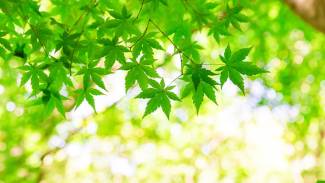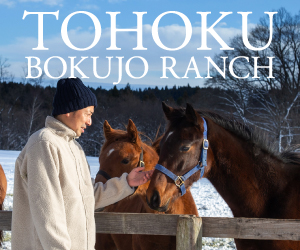YAMANASHI FOOD
FUJI COHOST RICH IN CULINARY OFFERINGS
Sponsored content
Luscious fruit, fine wine, flavorful beef, healthy fish are among the agricultural and livestock items on the menu
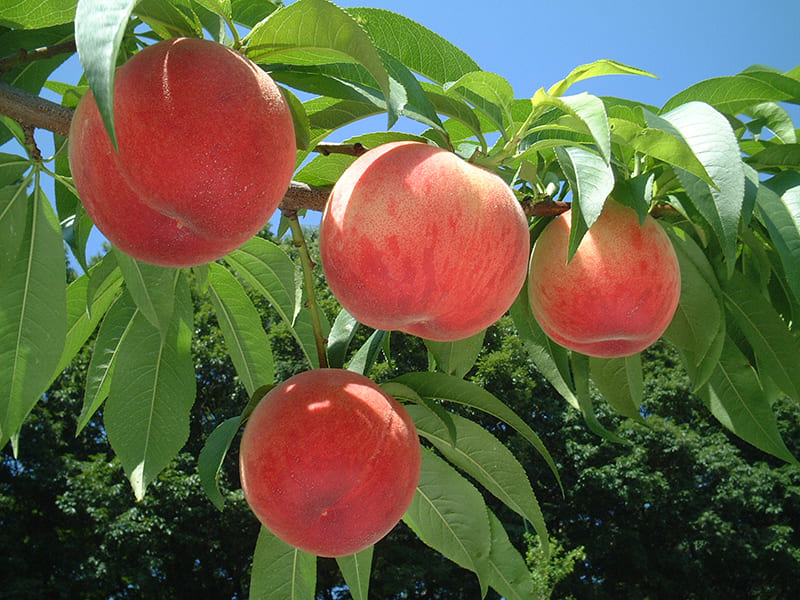
Yamanashi Prefecture is blessed with magnificent natural beauty such as Mount Fuji, the Fuji Five Lakes and Shosen Gorge, yet it can be reached in roughly one to two hours from central Tokyo by train, bus and car, making it a convenient sightseeing destination.
The prefecture is also known as a gourmet destination where visitors can enjoy a wide variety of agricultural and livestock products throughout the year, all nurtured by lush nature.
The key to the deliciousness of these products lies in water quality, and Yamanashi, surrounded by the Southern Alps and the Yatsugatake Mountains, boasts pristine, mineral-rich water. The region’s abundant sunshine, as well as its significant day and night temperature differences and well-drained soil, are ideal for fruit cultivation. The fruit farming in the Yamanashi’s Kyoto region has been recognized as a Globally Important Agricultural Heritage System by the Food and Agriculture Organization of the United Nations. The region is believed to be where Japanese grape cultivation started.
Yamanashi is Japan’s leading producer of grapes, peaches and plums. Beyond fruit, Yamanashi offers diverse culinary appeal, including tender and flavorful Koshu Beef, Fujinosuke, a new kind of locally bred salmon known for its low fat content and rich umami, and flavorful rice that pairs well with these gastronomic delights.
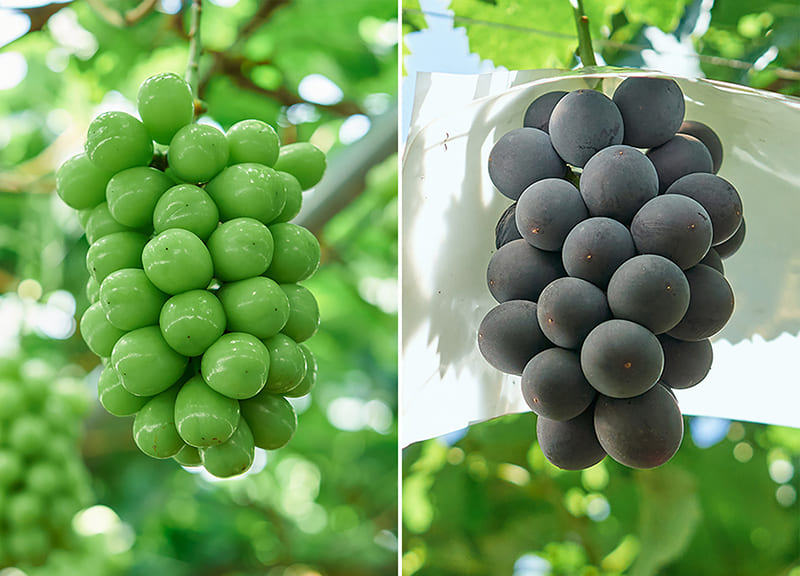
Fruit plays starring role
Peaches symbolize the array of summer fruits cultivated in Yamanashi. There is a wide variety, and some get harvested as early as mid-June. Each variety typically has a harvest period of about a week. Since the prefecture cultivates many varieties with different ripening cycles, fresh peaches can be enjoyed until early September.
The peaches include those with white flesh and those with yellowish flesh. Their texture can range from very soft to firm, and their sweetness levels also differ significantly.
Among these, Yumemizuki peaches are notable for their large size and sweetness. Developed by a prefectural facility that experiments with fruit trees, Yumemizuki peaches have milky-white flesh that contrasts beautifully with its vibrant, deep pink skin. The flesh is low in fiber, making it exceptionally succulent. While delicious eaten fresh, this variety is also used as an ingredient in desserts and other dishes. “You can simply freeze the mashed flesh to enjoy as an exquisite sherbet,” said Rina Suzuki, a Yamanashi Prefectural Government Marketing and Export Support Division staffer.
Another large, original Yamanashi variety developed by the facility is Yumetoka. It ripens relatively early, from late June to mid-July, and resists softening. In many kinds of fruit, the most intense flavor is found right where the skin meets the flesh. These firm peaches have skin that adheres tightly to the flesh, allowing them to be enjoyed whole with a crisp sensation when bitten. The firm texture makes it less prone to softening, making them relatively long-lasting and well-suited for export.
Plums are another fruit that can be enjoyed in summer. Like the peaches, varieties with different harvest times are cultivated so plums remain available from early June to early September.
One notable variety is Kiyo, harvested from mid-July to early August. These plums are exceptionally large, often weighing over 200 grams, with some well-grown examples even exceeding 300 g. Kiyo stands out for its low acidity and high sweetness compared with regular plums.
“This unique variety completely refreshes the traditional image of plums, making it highly popular as a gift,” Suzuki said.
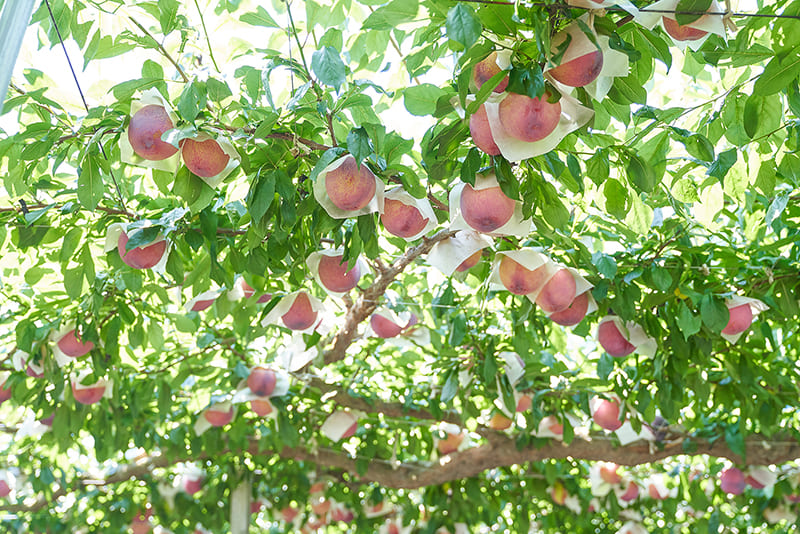
Japan’s grape capital
Grapes can be enjoyed over a long period from summer into autumn. Yamanashi Prefecture boasts the largest grape cultivation area and production volume in Japan. There are several theories about the origin of grape cultivation in Yamanashi, one of which suggests that it was introduced by the renowned Buddhist monk Gyoki about 1,300 years ago. The grape believed to have been cultivated at that time is Koshu, which is still grown today as both table and wine grapes. Koshu wine, known for its compatibility with Japanese food, is also exported overseas.
Currently, Shine Muscat is the most produced variety in Yamanashi. Open-field grapes are usually harvested from mid-August to late October. Some are also greenhouse-grown, allowing for earlier harvests starting in late April.
Noted for its edible bright yellow-green skin and large size, its bursting juiciness offers a refreshing sweetness. Grapes with a yellowish tint tend to be sweeter, and the white powdery coating on the skin, called “bloom,” protects it from drying out, signaling freshness.
A new variety announced in 2023 is Sunshine Red, characterized by its red skin and distinctive sweetness. This grape was developed by the Yamanashi Fruit Tree Experiment Station over a period of 15 years in response to requests from growers and markets for a red variety that exhibits the excellent characteristics of Shine Muscat and can be eaten with the skin.
“Another characteristic is the glamorous aroma that spreads throughout the mouth, and right before harvest time, all the Sunshine Red grape farms are enveloped in a fragrance of muscat,” said Masayuki Kobayashi, who works at the Yamanashi Fruit Tree Experiment Station.
Achieving Sunshine Red’s beautiful red color requires precise light control. Growers carefully prune branches to ensure optimal sunlight exposure and cover each cluster with a bag to ward off pests and disease.
Shortly before harvest, the bags are removed, leaving only a paper cap attached to the top of each cluster, with white sheets laid out on the ground. This method allows the grapes to receive an even and appropriate amount of light not just from directly from the sun, but indirectly from light reflected by the sheets and paper caps, helping them to develop their vivid skin color.
“Sunshine Red is the result of years of research and the exceptional skills of Yamanashi’s grape producers,” Kobayashi said.
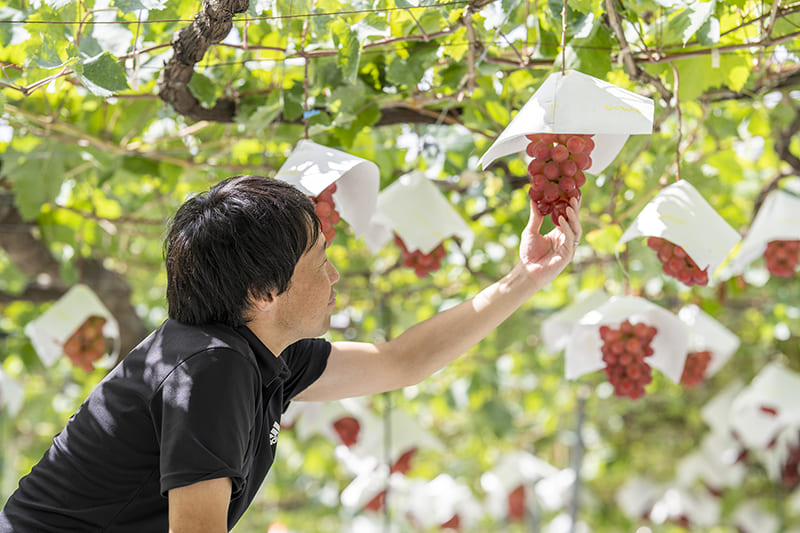
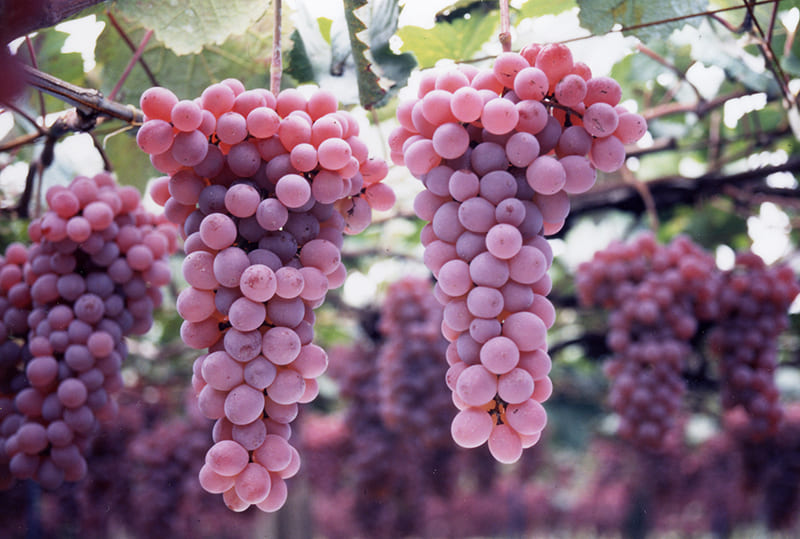
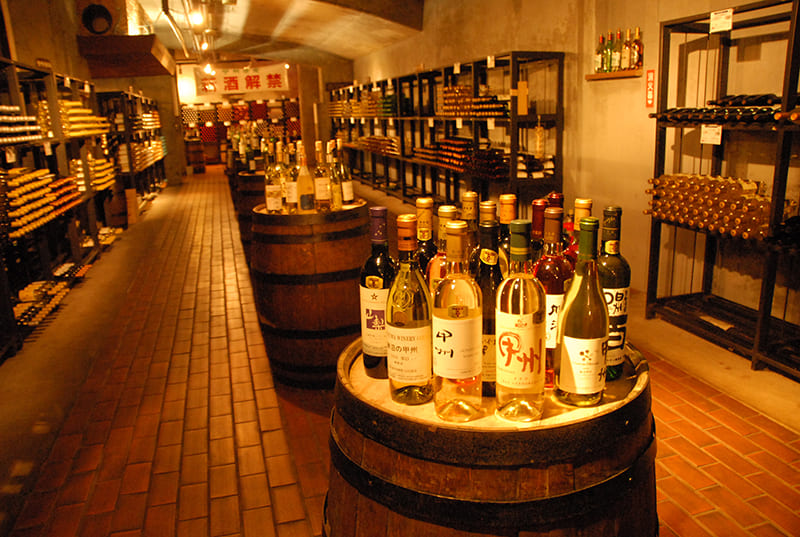
Producing premium rice
Yamanashi Prefecture is also known for its rice production. Premium brand Rihoku-mai Koshihikari is cultivated in an environment that offers ideal growing conditions, including high-quality water from the Southern Alps, fertile soil and extensive sunshine.
Cultivated with passion by dedicated producers, this rice boasts a perfect balance of flavor, luster and aroma, making it a flagship product of Yamanashi. It received the highest rating in the Japan Grain Inspection Association’s Rice Taste Ranking from 2012 to 2016.
Norin No. 48 is a rare and highly sought-after variety sometimes called “mythical rice.” It is primarily cultivated in the area traditionally called Mukawasuji on the right bank of the Kamanashi River in the cities of Hokuto and Nirasaki, a region considered ideal for rice.
It is known for its luster, pure whiteness, low stickiness, and rapid development of umami when steamed. As a hard-to-find variety available only in the prefecture, it is traded at premium prices.
Niji no Kirameki is a newer variety registered in 2022. It is resistant to high summer temperatures and maintains its quality well. Its stems are relatively short and less prone to lodging, making it resilient to typhoons and other severe weather events. “Its large, plump and pleasantly chewy grains get sweeter as you eat — it’s truly delicious,” said a prominent chef living in Yamanashi. It remains delicious even when cooled, so it’s suited for bento and rice balls.
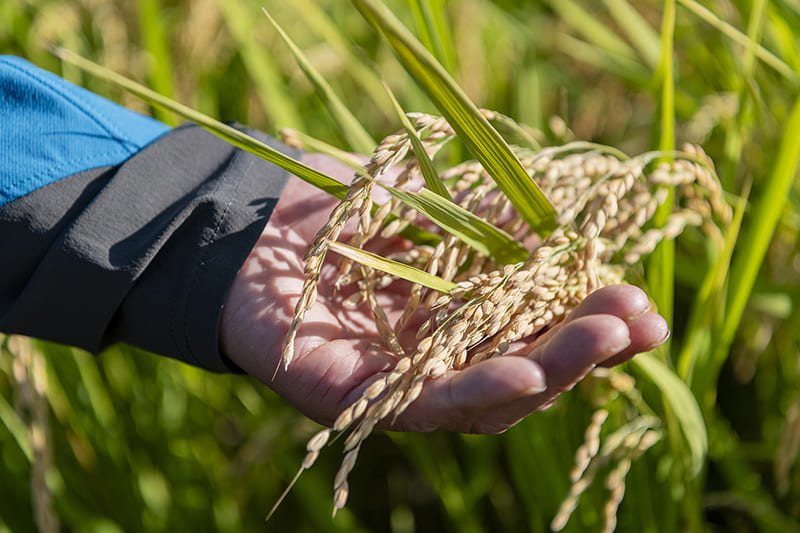
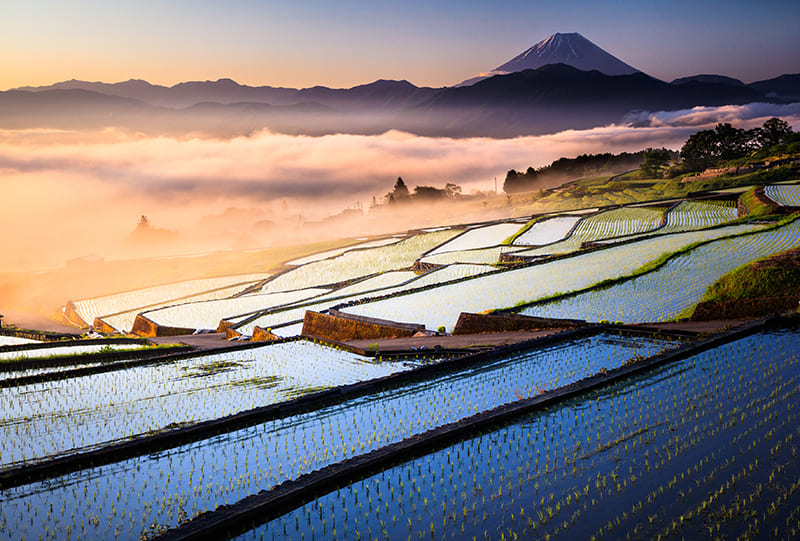
Premium wagyu, unique brands
Yamanashi Prefecture is also renowned for its livestock products, particularly Koshu Beef, a brand registered in 1989. Of all the meat produced from the Japanese Black breed of cattle, which are carefully nurtured in Yamanashi’s rich natural environment using refined techniques, only beef designated Grade 4 or 5 on the Japanese wagyu grading system is sold under the Koshu Beef brand.
Koshu Beef is known for its tender texture, vibrant color and rich flavor. It offers a juicy, melt-in-your-mouth feel when grilled as steak, and is also well-suited for cooking methods that highlight the deliciousness of its fat, such as shabu-shabu and sukiyaki.
Koshu Wine Beef is another unique product of Yamanashi, which also happens to be one of Japan’s leading wine regions. This specialty beef comes from cattle that are raised on a mixture of grape pomace (a byproduct of wine-making), corn that is not genetically modified and other ingredients.
The pomace contains high levels of quality fiber and polyphenols. The skins, seeds and enzymes in the pomace contribute to the meat’s exceptionally fine texture, tenderness, subtle sweetness and a rich umami.
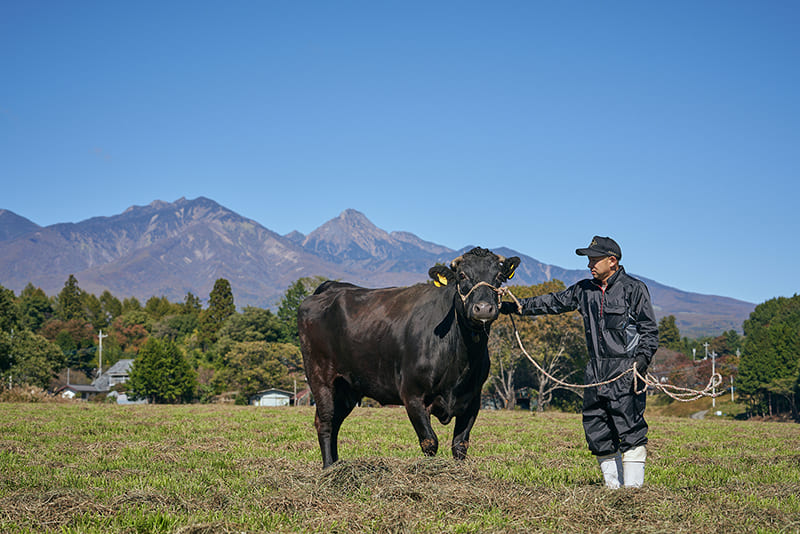
Freshwater fish make a splash
Though Yamanashi is one of the eight landlocked prefectures in Japan, it is also a producer of high-quality fish. The Fujinosuke brand was developed by crossbreeding king salmon and rainbow trout under strict criteria.
First, all fish under the brand must originate from eggs produced by the Yamanashi Prefectural Fisheries Technology Center. Then they must be raised on safe, heat-processed feed and meet standards for preservation and flesh color at the time of shipment. Fujinosuke is the only hybrid variety in Japan that inherits the lineage of king salmon, which is considered the best of the salmon species.
Fujinosuke fish are characterized by a vivid pink color, fine texture, well-balanced fat and rich umami. They are suitable for sushi, sashimi and processed products, such as miso-marinated saikyo-zuke and smoked fish.
According to a report by the Yamanashi Prefectural Government’s Department of Agricultural Policy, Fujinosuke tends to have higher protein, less fat and fewer calories than Atlantic salmon. It is also 1.6 times higher in aspartic acid and glutamic acid, which are components of umami, and 1.5 times richer in vitamin D than rainbow trout.
Research shows that Fujinosuke is best eaten raw about 36 to 48 hours after harvested, and that its freshness can be maintained by storing it at 4 degrees if harvested and bled using the method developed by the Yamanashi Prefectural Fisheries Technology Center.
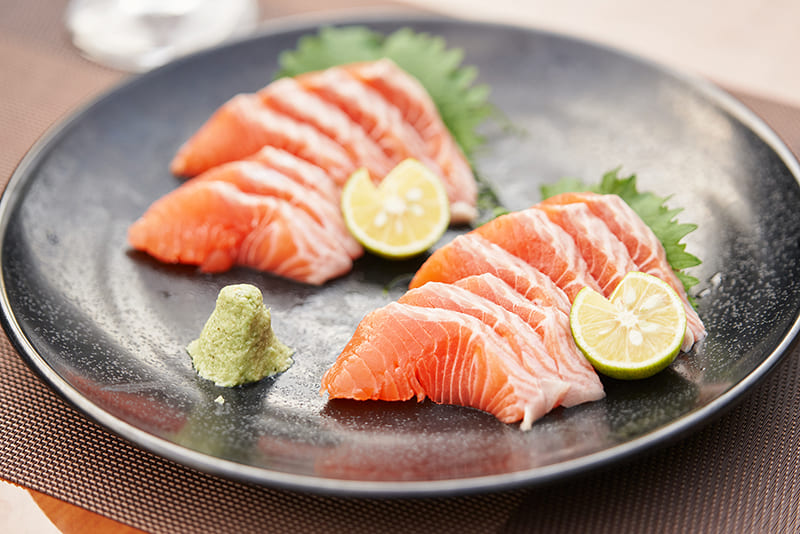
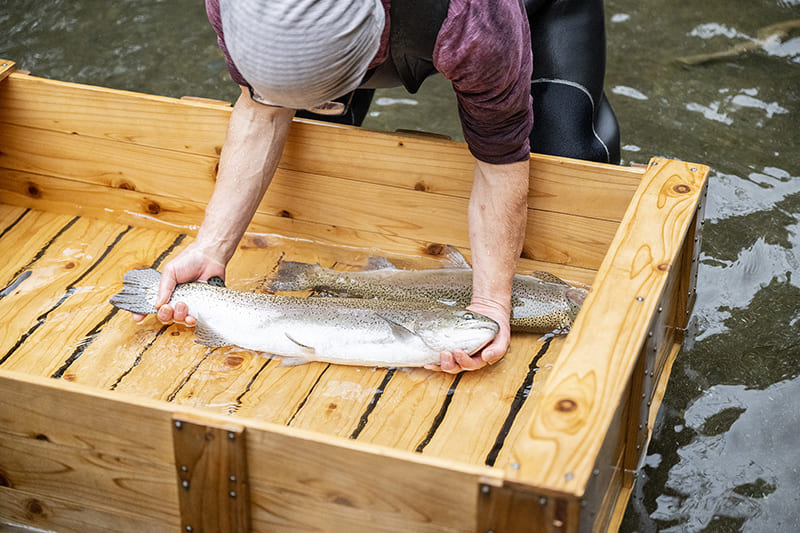
Envisioning a ‘delicious future’
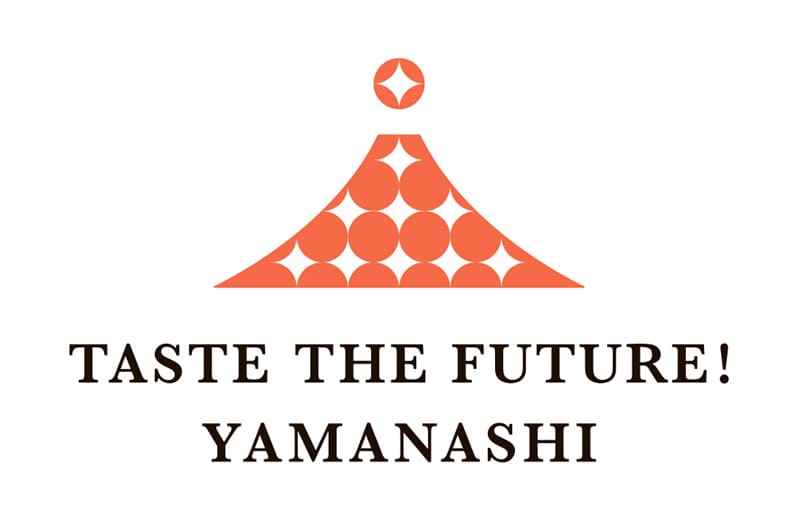
While some of the Yamanashi products mentioned here are available outside the prefecture, enjoying these local treasures right at the source offers a truly special experience.
“To invite more people to savor Yamanashi’s culinary delights, we have created a webpage featuring restaurants where you can taste various agricultural, livestock and fishery products of the prefecture, as well as stores where you can purchase them,” Suzuki said.
The Yamanashi Prefectural Government has launched a promotional campaign under the slogan “Taste the Future! Yamanashi,” accompanied by a logo inspired by Mount Fuji — the source of its abundant natural blessings.
This branding, designed to cultivate a “delicious future,” is permitted for use on products that meet prefectural inspection standards, originate from producers whose excellent practices are recognized, or result from environmentally safe and sustainable methods.
Through this initiative, Yamanashi aims to promote the appeal of its safe and sustainable farm, livestock and fisheries products both in Japan and internationally.
The dedicated website for “Taste the Future! Yamanashi” features information on its sustainability initiatives, including animal welfare and decarbonization efforts, articles and videos on local producers, as well as product recommendations and participating stores. Yamanashi’s official social media accounts also share information about the diverse delicacies and tourist attractions of Tokyo’s mountainous neighbor.
This article is sponsored by the Yamanashi Prefectural Government. For more information, please visit: www.pref.yamanashi.jp/oishii-mirai/foreign/index.html; and www.pref.yamanashi.jp.e.aao.hp.transer.com/nou-han/kaigai_johohasshin.html
Find local restaurants or shops at: www.pref.yamanashi.jp.e.aao.hp.transer.com/oishii-mirai/yamanashi_stores.html



